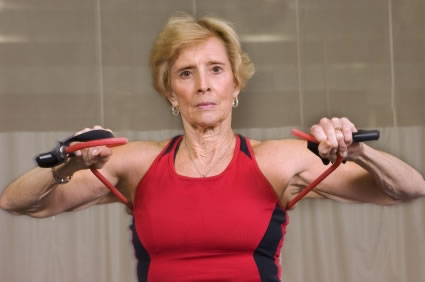Published: March 15, 2012

Stockxpert
his study demonstrates that exercise training, including resistance exercise training, is a feasible, low-risk treatment that can potentially reduce worry symptoms among generalized anxiety disorder (GAD) patients and may be an effective adjuvant, short-term treatment or augmentation for GAD.
A randomized controlled trial published in the current issue of Psychotherapy and Psychosomatics addresses the role of exercise training in anxiety. Exercise training may be especially helpful for patients with generalized anxiety disorder (GAD). A randomized controlled trial to quantify the effects of 6 weeks of resistance (RET) or aerobic exercise training (AET) on remission and worry symptoms among sedentary patients with GAD was conducted. Thirty sedentary women aged 18–37 years, diagnosed by clinicians blinded to treatment allocation with a primary DSM-IV diagnosis of GAD and not engaged in any treatment other than pharmacotherapy, were randomly allocated to RET, AET, or a wait list (WL). RET involved 2 weekly sessions of lower-body weightlifting. AET involved 2 weekly sessions of leg cycling matched with RET for body region, positive work, time actively engaged in exercise, and load progression.
Remission was measured by the number needed to treat (NNT). Worry symptoms were measured by the Penn State Worry Questionnaire. There were no adverse events. Remission rates were 60%, 40%, and 30% for RET, AET, and WL, respectively. The NNT was 3 (95% CI 2 to 56) for RET and 10 (95% CI –7 to 3) for AET. A significant condition-by-time interaction was found for worry symptoms. A follow-up contrast showed significant reductions in worry symptoms for combined exercise conditions versus the WL. Exercise training, including RET, is a feasible, low-risk treatment that can potentially reduce worry symptoms among GAD patients and may be an effective adjuvant, short-term treatment or augmentation for GAD. Preliminary findings warrant further investigation.
ᔥ Journal of Psychotherapy and Psychosomatics Herring, M.P. ; Jacob, M.L. ; Suveg, C. ; Dishman, R.K. ; O’Connor, P.J. Feasibility of Exercise Training for the Short-Term Treatment of Generalized Anxiety Disorder: A Randomized Controlled Trial. Psychother Psychosom 2012;81:21-28
Published: February 20, 2012

Image: istockphoto
ou may feel productive putting in long days at the office. But while your mind is active, your body isn’t. There is a growing body of research that supports the idea that, regardless of your exercise routine after hours, the more time you spend sitting each day, the higher your risk of heart disease. Evidence suggests your hips, spine and shoulders suffer as well.
“It’s important to get up and move around throughout the day. Exercise not only helps with how you feel physically, but it also improves your mind and your memory.”” says Julia Henderson-Kalb, a Saint Louis University occupational therapist. “
While it’s not always feasible to hit the gym at lunchtime, some small changes to your routine can add up quickly to make a positive impact your health.
Henderson-Kalb suggests these simple habits to help you increase your daily activity in a substantial way.
• Sit on an exercise ball instead of a chair. You’ll strengthen your abdominal and back muscles and improve your posture.
• Set an alarm to go off every hour to remind yourself to stand up and stretch. Get in the habit of walking around your office while you talk on the phone.
• Always take the stairs and use the restrooms on another floor.
• Park far away from the entrance to your office building. Wear a pedometer and aim to get 6,000-10,000 steps per day.
• Bring your lunch to work. Not only is it less expensive and can be healthier, but you’ll leave time in your day to take a lunchtime walk or exercise break.
• Bring light weights or exercise bands to the office and build an exercise routine into your day. Follow this link for specific exercises and a demonstration.
To hear more about the importance of avoiding sedentary work days, visit: http://www.youtube.com/watch?v=iz35RPBQlyI&feature=related
Source: Saint Louis University Medical Center
Published: January 21, 2012
 Approximately 3 percent of the U.S. population suffers from excessive, uncontrollable worry that reduces their health and quality of life. The condition, known as Generalized Anxiety Disorder, is difficult to overcome and is accompanied by a host of physical symptoms, including fatigue, muscle tension, irritability and poor sleep. However, a new University of Georgia study shows that regular exercise can significantly reduce anxiety symptoms in patients with GAD.
Approximately 3 percent of the U.S. population suffers from excessive, uncontrollable worry that reduces their health and quality of life. The condition, known as Generalized Anxiety Disorder, is difficult to overcome and is accompanied by a host of physical symptoms, including fatigue, muscle tension, irritability and poor sleep. However, a new University of Georgia study shows that regular exercise can significantly reduce anxiety symptoms in patients with GAD.
In a study published online in the Nov. 22 edition of Psychotherapy and Psychosomatics, researchers randomly assigned 30 sedentary women, ages 18-37 who were diagnosed with GAD, to either a control group or six weeks of strength or aerobic exercise training. Women in the exercise conditions completed two weekly sessions of either weight lifting or leg cycling exercise. Remission of the disorder, determined by psychologists who were unaware of the treatment each client received, was higher among exercisers and best among those who performed weight lifting exercise. Worry symptoms, the primary problem among individuals with GAD, were significantly reduced among the exercisers, and moderate-to-large improvements in other symptoms, such as irritability, feelings of tension, low energy and pain, were found. [continue reading…]
Published: November 30, 2011
 New research suggests that surges in a brain protein after exercise may play a particular role in improving memory and recall.
New research suggests that surges in a brain protein after exercise may play a particular role in improving memory and recall.
As I ready myself to partake in my daily exercise this piece in the The New York Times why exercise benefits the brain caught my attention:
For some time, scientists have believed that BDNF helps explain why mental functioning appears to improve with exercise. However, they haven’t fully understood which parts of the brain are affected or how those effects influence thinking. The Irish study suggests that the increases in BDNF prompted by exercise may play a particular role in improving memory and recall. link to read more
Source: New York Times



